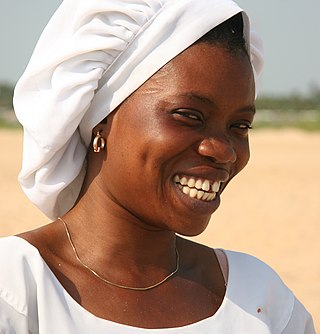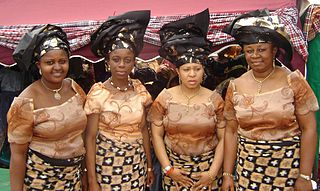
Sub-Saharan Africa, Subsahara, or Non-Mediterranean Africa is the area and regions of the continent of Africa that lie south of the Sahara. These include Central Africa, East Africa, Southern Africa, and West Africa. Geopolitically, in addition to the African countries and territories that are situated fully in that specified region, the term may also include polities that only have part of their territory located in that region, per the definition of the United Nations (UN). This is considered a non-standardized geographical region with the number of countries included varying from 46 to 48 depending on the organization describing the region. The African Union (AU) uses a different regional breakdown, recognizing all 55 member states on the continent—grouping them into five distinct and standard regions.

In the United States government, the Bureau of African Affairs (AF) is part of the U.S. Department of State and is charged with advising the Secretary of State on matters of Sub-Saharan Africa. The bureau was established in 1958. It is headed by the Assistant Secretary of State for African Affairs who reports to the Under Secretary of State for Political Affairs. Molly Phee is the current Assistant Secretary.
The history of education in Africa can be roughly divided into pre- and post- colonial periods. Since the introduction of formal education to Africa by European colonists, African education, particularly in West and Central Africa, is characterised by both traditional African teachings and European-style schooling systems. The state of education reflects not only the effects of colonialism, but instability resulting from and exacerbated by armed conflicts in many regions of Africa as well as fallout from humanitarian crises such as famine, lack of drinking water, and outbreaks of diseases such as malaria and Ebola, among others. Although the quality of education and the quantity of well-equipped schools and teachers has steadily increased since the onset of the colonial period, there are still numerous inequalities evident in the existing educational systems based on region, economic status, and gender.
The Forum for African Women Educationalists (FAWE) is a pan-African non-governmental organization founded in 1992 by five women ministers of education to promote girls’ and women's education in sub-Saharan Africa by making sure they have access to schools and are able to complete their studies and fulfill their potential, in line with UNESCO's Education For All movement. The organisation's members include ministers of education, university vice-chancellors, education policy-makers, researchers, gender specialists and human rights activists.
Contributing to the establishment of human rights system in Africa are the United Nations, international law and the African Union which have positively influenced the betterment the human rights situation in the continent. However, extensive human rights abuses still occur in many sections of the continent. Most of the violations can be attributed to political instability, racial discrimination, corruption, post-colonialism, economic scarcity, ignorance, illness, religious bigotry, debt and bad financial management, monopoly of power, lack/absence of judicial and press autonomy, and border conflicts. Many of the provisions contained in regional, national, continental, and global agreements remained unaccomplished.

The individual member states of the African Union (AU) coordinate foreign policy through this agency, in addition to conducting their own international relations on a state-by-state basis. The AU represents the interests of African peoples at large in intergovernmental organizations (IGO's); for instance, it is a permanent observer at the United Nations' General Assembly.

The crowned bullfrog is a species of frog in the family Dicroglossidae. It is found in the Sub-Saharan Africa . Its natural habitats are subtropical or tropical moist lowland forest, dry savanna, moist savanna, subtropical or tropical dry shrubland, subtropical or tropical moist shrubland, subtropical or tropical dry lowland grassland, subtropical or tropical seasonally wet or flooded lowland grassland, rivers, intermittent rivers, freshwater lakes, intermittent freshwater lakes, freshwater marshes, intermittent freshwater marshes, freshwater springs, arable land, pastureland, rural gardens, heavily degraded former forest, and ponds.

The legal status of prostitution in Africa varies widely. It is frequently common in practice, partially driven by the widespread poverty in many sub-Saharan African countries, and is one of the drivers for the prevalence of AIDS in Africa. Senegal and Côte d'Ivoire permit the operations of brothels. In other countries, prostitution may be legal, but brothels are not allowed to operate. In some countries where prostitution is illegal, the law is rarely enforced.
The Network of African National Human Rights Institutions (NANHRI) is one of four regional groupings within the global network, the Global Alliance for National Human Rights Institutions (GANHRI). NANHRI promotes the establishment of national human rights institutions throughout Africa, and supports co-operation and training to strengthen and develop the monitoring, promotion, protection and advocacy work of African NHRIs.

Tourism is an important economic sector for many countries in Africa. There are many countries that benefit heavily from tourism like Uganda, Algeria, Egypt, South Africa, Kenya, Morocco, Tunisia, Ghana and Tanzania. The touristic particularity of Africa lies in the wide variety of points of interest, diversity and multitudes of landscapes as well as the rich cultural heritage. Also, an ecotourist industry is present in some African countries.

Access to safe and adequate sexual and reproductive healthcare constitutes part of the Universal Declaration of Human Rights, as upheld by the United Nations.

Women in Benin have gained more rights since the restoration of democracy and the ratification of the Constitution, and the passage of the Personal and Family Code in 2004. These both overrode various traditional customs that systematically treated women unequally. Still, inequality and discrimination persist. "Girls from the age of five or so are actively involved in housekeeping, sibling care, and agriculture." Society could think about of a woman's role are a housemaid, caretaker, or babysitter. A woman's role is to be a housemaker and nothing at all, but women have much potential to be more than a housemaker. With laws taking charge of what a woman can be as a career of how they are being useful more in the house than in a men's job position. Moreover, these rules apply to women by their gender that has not changed for a while. And there has been inequality based on being the opposite gender which these rules should immediately change if the society wants to get better to have equality for the female race.

On Transparency International's 2023 Corruption Perceptions Index, Senegal scored 43 on a scale from 0 to 100. When ranked by score, Senegal ranked 70th among the 180 countries in the Index, where the country ranked first is perceived to have the most honest public sector. For comparison with worldwide scores, Senegal's score was also the average score in 2023; the best score was 90 and the worst score was 11. For comparison with regional scores, the average score among sub-Saharan African countries was 33. The highest score in sub-Saharan Africa was 71 and the lowest score was 11.

There are several sectors in Ethiopia where businesses are particularly vulnerable to corruption. Land distribution and administration is a sector where corruption is institutionalized, and facilitation payments as well as bribes are often demanded from businesses when they deal with land-related issues.

Female empowerment in Nigeria is an economic process that involves empowering Nigerian women as a poverty reduction measure. Empowerment is the development of women in terms of politics, social and economic strength in nation development. It is also a way of reducing women's vulnerability and dependency in all spheres of life. It can be noted that the aggregate of educational, political, health and legal empowerment are key to women's empowerment in Nigeria. Like many African women, Nigerian women have a subordinate role to their male counterparts. There are twice as many women below the poverty line than men and up to 19 times as many men in executive positions than women.
The colonial roots of gender inequality refers to the political, educational, and economic inequalities between men and women in Africa. According to a Global Gender Gap Index report published in 2018, it would take 135 years to close the gender gap in Sub-Saharan Africa and nearly 153 years in North Africa. While much more is known about the effects of colonialism on all African people, less is known about the impacts of colonialism on specifically women. There are competing theories about the cause of gender inequality in Africa, but scholars suggest its genesis is in slavery and colonialism. For most women, colonialism resulted in an erosion of traditions and rights that formerly granted women equality and esteem. Women in pre-colonial Africa held positions of power and were influential in many aspects of their societies. This changed during the post-colonial period. With new forms of gender inequality introduced, many of the cultural underpinnings of African societies were eroded, and this harm has been challenging to mend. Theoretical frameworks that help to explain the colonial roots of gender inequality include coloniality of power and coloniality of gender. These decolonial concepts provide an account of how gender inequality became situated within the African context and help to explain why present-day inequalities, including women's political underrepresentation, remain significant challenges for Africa.
In this article, NGOs in West Africa will be divided into three categories: African national NGOs, African international NGOs, and non-African international NGOs. NGOs stand for non-governmental organizations. These organizations are mostly non-profit and mostly work independently from the government, they have specific aims that range from human rights, finance, health, education and more. There are many non-governmental organizations in West Africa, and much activity between these countries, organizations and the rest of the world.















